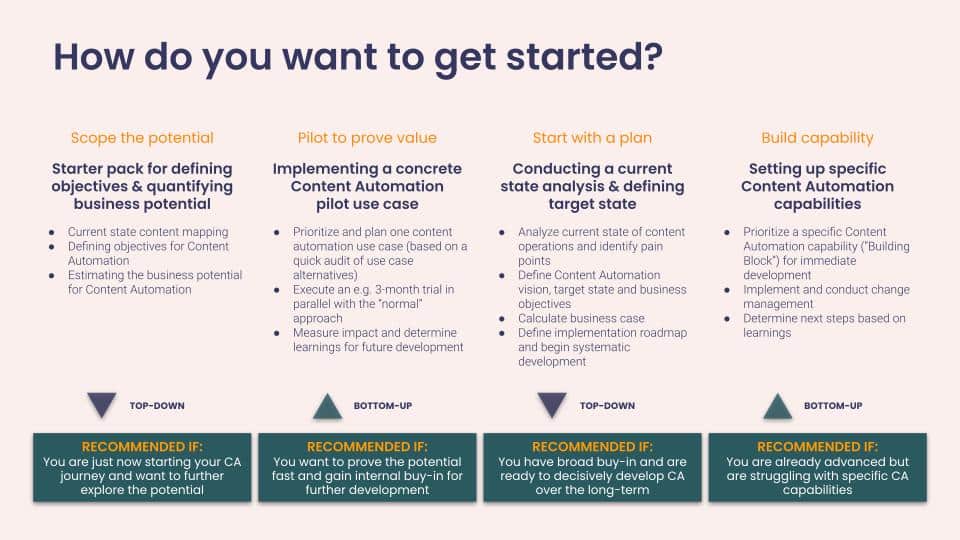This article presents a summary and the main takeaways from a breakfast event at our Helsinki office.
Are you also feeling the pressure of producing enough personalized content to satisfy audience demands?
This problem, often referred to as the content bottleneck, occurs when the need for customized content surpasses the speed of production. At Avaus we’ve been investigating this trend across industries and see content automation as a crucial solution.
The problem: a content bottleneck
The essence of the content bottleneck is simple: the growing demand for personalized customer experiences across channels and touchpoints quickly drives up the volume and complexity of content requirements – meeting these requirements becomes increasingly challenging. This leads to missed opportunities and increased pressure on marketing teams. As personalization and automation becomes more critical for engaging audiences, the bottleneck only tightens, limiting what businesses can achieve with their content strategies.
How can content automation help?
Content automation, sometimes referred to as the content supply chain, involves using technology to streamline the creation, management, and optimization of content at scale. It’s about making the process faster and less labor-intensive, allowing teams to focus on the creative and strategic aspects of content marketing. With automation, businesses can scale their content production to meet personalization needs without overwhelming their teams.
What’s important to remember, however, is that content automation is much more about the processes and people, than the technical tools and systems.
5 steps to getting started with Content Automation
- Conduct a Thorough Audit: Start by assessing your current content creation and delivery processes. Identify where bottlenecks are occurring and pinpoint areas ripe for automation.
- Define Clear Objectives: What do you hope to achieve with automation? Whether it’s reducing the time to market, enhancing content personalization, or improving operational efficiency, setting clear goals will guide your automation efforts.
- Select Appropriate Tools: Not all automation tools are created equal. Choose solutions that not only address your immediate needs but also integrate seamlessly with your existing digital infrastructure. This might include content management systems, AI-driven content creation tools, or analytics platforms to measure performance.
- Educate and Train Your Team: Successful automation relies on your team’s ability to use new tools effectively. Manage change ongoingly and provide training and resources to ensure everyone is up to speed. Remember, the goal is to augment their capabilities, not replace their roles.
- Pilot and Learn: Launch a pilot project to apply automation in a controlled environment. Use this as a learning opportunity to understand the impacts of automation on your workflow and content quality. This approach allows for adjustments before a full-scale rollout.
Practical benefits of content automation include the ability to produce a large volume of content variations tailored to different audience segments quickly, ensuring content is always fresh and relevant. It also simplifies managing content versions, reducing errors, and ensuring consistency across all platforms. Perhaps most importantly, automation supports dynamic personalization, enabling content to adapt in real-time to user interactions, making experiences more engaging and effective.
Can this be a competitive edge for your organisation?
Adopting content automation isn’t just about keeping up with the competition; it’s about setting the stage for future growth. As customer expectations for personalized experiences continue to rise, automation will be key to delivering on these expectations efficiently. Moreover, it’s a pathway to freeing your creative team from mundane tasks, allowing them to invest their energy in innovation and strategic thinking.
Content automation is more than a trend; it’s a strategic necessity in the modern digital landscape. By embracing automation, businesses can navigate through the content bottleneck, improve their marketing effectiveness, and deliver personalized experiences at scale. It represents a significant shift towards more agile, responsive, and customer-focused content strategies.
Let us guide you on the right path to success!
We are happy to discuss what the next steps on your Content Automation journey could entail. Here are four ways you can get the needed support to make sure you’re set off on the right track:
Click on the image for a closer look.
Read more about content automation
